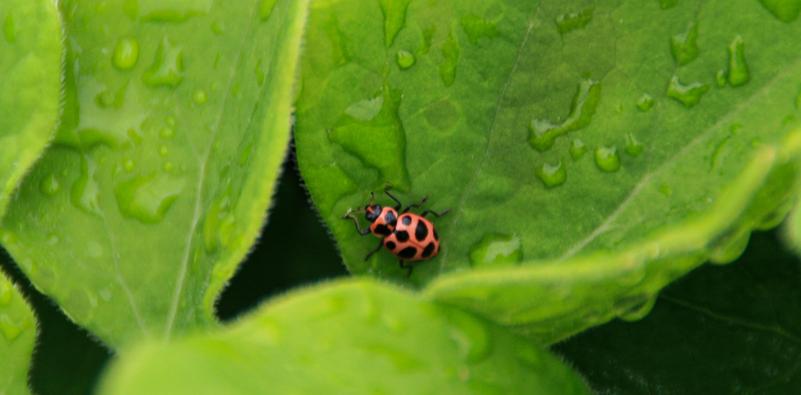Shade Happens. Procumbens Prevails.
One of the only temperate Buxaceae family members worth talking about besides Sarcococca sp. (and I will fight you with my whole chest defending that argument) is our native, creeping evergreen groundcover, Pachysandra procumbens. Endemic to Mid-Atlantic woodlands and aptly called Allegheny spurge, Pachysandra procumbens is often overlooked for its more dense, vigorously growing Japanese cousin, Pachysandra terminalis. You may be familiar with Japanese spurge, as most people are, primarily due to everybody’s grandmother planting it back in the 70’s, allowing it to live long and prosper throughout suburbia for the last half a century.
Low-growing, evergreen thickets form over time and are a pain to remove (ask me how I know!), the unfortunate gardener at the whim of a dense rhizomatous supersystem below the soil. Our better behaved and arguably more attractive Pachysandra procumbens forms its colonies slower, more mindfully, allowing the designer to interplant without worrying about more sensitive native plants being outcompeted. Soft, blue-green leaves mottled with patches of ivory and occasionally dark mauve give the shady, woodland floor almost an iridescent appearance, as though moonlight were hitting the foliage at the height of daytime beneath the canopy overhead.
Similar to the short-lived but eagerly-awaited blooms of Sarcococca hookeriana var. humilis, the springtime flowers borne to Allegheny spurge are small, demure, and highly fragrant. Ironically showier and more highly conspicuous than the terminal inflorescences of Japanese spurge, Allegheny spurge offers a floral display reminiscent of a more densely packed, fleshier foamflower (Tiarella sp.), despite their emergence below the foliage as opposed to directly atop. It’s hard not to notice the procumbent flower spikes, as they demand you stop and investigate the pleasant aroma that is not immediately seen at eye-level when wandering through the woodland garden.
Unfortunately, not much is known about the faunal relationships between Pachysandra procumbens and its fellow woodland inhabitants, and because of limited and often rare wild populations in its native range, studying such symbioses is difficult. Bees and beneficial predators such as ichneumon and braconid wasps have been observed gathering nectar from the short flower spikes in early spring when other food sources are still somewhat scarce.
Watching a patch of Pachysandra procumbens for several minutes will introduce a host of tiny visitors - in the few minutes I stood watching our crop here at the nursery, I witnessed a 14-spotted lady beetle, several pink spotted lady beetles “interacting” with one another, and a curious-looking stilt-legged fly (Taeniaptera lasciva, pictured two photos below) performing its characteristic ritual of rubbing its front legs together in an act of wasp mimicry. The dense, low-growing nature of Allegheny spurge allows these tiny creatures to hide from potential predators and provides shelter for their next generations.
It seems that most of our grandmothers planted Japanese spurge for its deer resistance, a characteristic which our own Allegheny spurge also possesses, plus the benefit of being a non-problematic native species. Its deer resistance extends further to other typical herbivores such as rabbits due to the presence of phytotoxins that can be fatal if consumed in high enough quantities. Interestingly, lab studies have found beneficial compounds within Pachysandra procumbens’ genetic structure.
Estrone sulfatase, an enzyme that acts as a control for the containment and release of estrogen and is often responsible for the onset of breast cancer, has been a topic of research for decades, prompting investigation into the cure for the most common disease worldwide. This enzyme can be inhibited by sulfatase inhibitors that act as anti-estrogen binding sites and thus reduce carcinogenic risk (Chang et al., 2000). Pachysandra species, particularly Pachysandra procumbens, have been found to contain considerable levels of anticancer, antiestrogenic, and even antimicrobial compounds, and show significant promise in future anticancer therapies for their sulfatase-inhibition.
Besides its biological importance as a cancer-inhibitor and its potential for use in future immunotherapies, Pachysandra procumbens can also be used more passively in a shady healing garden. Besides offering soft, vibrant green foliage to the bed of the garden and keeping down the need for mulch, the flowers invite children of all ages to search for the source of their lovely floral fragrance, prompting movement, touch, and exploration, all the while providing delicate aromatherapeutic benefits that provide sensory relief.
Pachysandra procumbens is slowly gaining popularity amongst the masses who are only just learning about the benefits of native plants, meaning now is the time to embark on your journey as an Allegheny spurge Ambassador and set the trends for shade gardens of the future. They are currently available in quart sizes and are actively pushing new growth - add them to your next order and get them before they’re gone!
See all our Perennials


